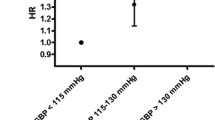Abstract
In 1988, the U.S. Food and Drug Administration proposed guidelines for the clinical evaluation of new antihypertensive drugs. According to these guidelines, the drug effect at trough (measured as the difference in blood pressure values from placebo) should be no less than one half to two thirds of the peak effect. Unfortunately, calculation of the trough/peak ratio suffers the consequences of many methodological, interpretative, practical, and epidemiological problems. When taking readings at short time intervals, noninvasive ambulatory blood pressure monitoring allows evaluation of blood pressure variability by means of several statistical parameters. Blood pressure variability, measured as the standard deviation of the overall 24-hour blood pressure measurements, has been demonstrated to be significantly correlated with target-organ damage in hypertensive patients. Blood pressure variability may not change with long-acting antihypertensive agents, but it may increase with short-acting ones. Therefore, assessment of the trough/peak ratio may be overcome by the evaluation of drug-induced changes in the standard deviation of the mean 24-hour blood pressure.
Similar content being viewed by others
References
Food and Drug Administration. Proposed Guidelines for the Clinical Evaluation of Anti-hypertensive Drugs. Rockville, MD: Division of Cardio-Renal Drug Products, US Department of Health and Human Services, 1988.
Rose M, McMahon FG. Some problems with antihypertensive drug studies in the context of the new guidelines. Am J Hypertens 1990;3:151–155.
Lipicky RJ. Trough:peak ratio: The rationale behind the United States Food and Drug Administration recommendations. J Hypertens 1994;12(Suppl 8):S17–S19.
Elliott HL, Meredith PA: Trough:peak ratio: Clinically useful or practically irrelevant? J Hypertens 1995;13:279–283.
Mutti E, Trazzi S, Omboni S, Parati G, Mancia G: Effect of placebo on 24-h non-invasive blood pressure. J Hypertens 1991;9:361–364.
Gerin W, Rosofsky M, Pieper C, Pickering TG: A test of reproducibility of blood pressure and heart rate variability using a controlled ambulatory procedure. J Hypertens 1993;11:1127–1131.
Mancia G, Omboni S, Parati G, Trazzi S, Mutti E. Limited reproducibility of hourly blood pressure values obtained by ambulatory blood pressure monitoring: Implications for studies on antihypertensive drugs. J Hypertens 1992;10:1531–1535.
Mancia G, Ulian L, Parati G, Trazzi S. Increase in blood pressure reproducibility by repeated semi-automatic blood pressure measurement in the clinic environment. J Hypertens 1994;12:469–473.
Omboni S, Parati G, Zanchetti A, Mancia G. Calculation of trough-to-peak ratio of antihypertensive treatment from ambulatory blood pressure: Methodological aspects. J Hypertens 1995;13:1105–1112.
Myers MG. Trough-to-peak ratio and 24-hour blood pressure control. Methodological issues. Am J Hypertens 1995;8:214–219.
Menard J, Chatellier G, Day M, Vaur L. Self-measurement of blood pressure at home to evaluate drug effects by the trough:peak ratio. J Hypertens 1994;12(Suppl 8):S21–S25.
Meredith PA, Elliott H. Antihypertensive treatment and trough:peak ratio: General considerations. J Hypertens 1994(Suppl 8):S79–S83.
Meredith PA, Donnelly R, Elliott HL, Howie CA, Reid TL. Prediction of the antihypertensive response to enalapril. J Hypertens 1990;8:1085–1090.
Ménard J, Bellet M, Brunner HR: Clinical development of antihypertensive drugs. In: Laragh JH, Brenner BM, eds. Hypertension: Pathophysiology, Diagnosis, and Management. New York: Raven Press, 1995:3049–3063.
Olivari MT, Bartorelli C, Polese A, Fiorentini C, Moruzzi P, Guazzi MD. Treatment of hypertension with nifedipine, a calcium antagonist agent. Circulation 1979;59:1056–1062.
Meredith PA, Reid JL. Differences between calcium antagonists: Duration of action and trough to peak ratio. J Hypertens 1993;11(Suppl 1):S21–S26.
Meredith PA, Elliott HI. Amlodipine—Does the effect-time profile directly reflect the concentration-time profile throughout a 24-hour period? Clin Cardiol 1994;17(Suppl III):7–11.
Zanchetti A. Trough:peak ratio of the blood pressure response to dihydropyridine calcium antagonists. J Hypertens 1994;12(Suppl 8):S97–S106.
Zanchetti A, Bianchi L, Amigoni S, Omboni S, Villani A, Ravogli A. Antihypertensive effects of nifedipine gastrointestinal therapeutics system on clinic and ambulatory blood pressure in essential hypertensives. J Hypertens 1993;11(Suppl 5):S334–S335.
Strasser T, Wilhelmsen L. W.H.O. Regional Publications European Series No. 47, 1993.
Prattichizzo FA, Galetta F. How common is “white coat normotension”? Int Med—Clin Lab 1995;3:99–102.
Prattichizzo FA, Galetta F. White coat normotension and blood pressure variability. Angiology 1996;47:663–668.
Mancia G, Frattola A, Groppelli A, et al. Blood pressure reduction and end-organ damage in hypertension. J Hypertens 1994;12(Suppl 8):S35–S42.
Frattola A, Parati G, Cuspidi C, Albini F, Mancia G. Prognostic value of 24-hour blood pressure variability. J Hypertens 1993;11:1133–1137.
Prattichizzo FA, Galetta F. Effect of atenolol and benazepril on 24 hour blood pressure variability. Minerva Cardioangiol 1993;41:587–590.
Mancia G, Casadei R, Mutti E, Trazzi S, Parati G. Ambulatory blood pressure monitoring in the evaluation of antihypertensive treatment. Am J Med 1989;87(Suppl 6B):S64–S69.
Lipicky R. The United States Food and Drug Administration guidelines on ambulatory blood pressure monitoring. J Hypertens 1991;9(Suppl 8):S59.
Author information
Authors and Affiliations
Rights and permissions
About this article
Cite this article
Prattichizzo, F.A., Galetta, F. & Simonetti, I. Problems in the Evaluation of Antihypertensive Therapy Using the Trough/Peak Ratio. Cardiovasc Drugs Ther 11, 459–463 (1997). https://doi.org/10.1023/A:1007749522688
Issue Date:
DOI: https://doi.org/10.1023/A:1007749522688




